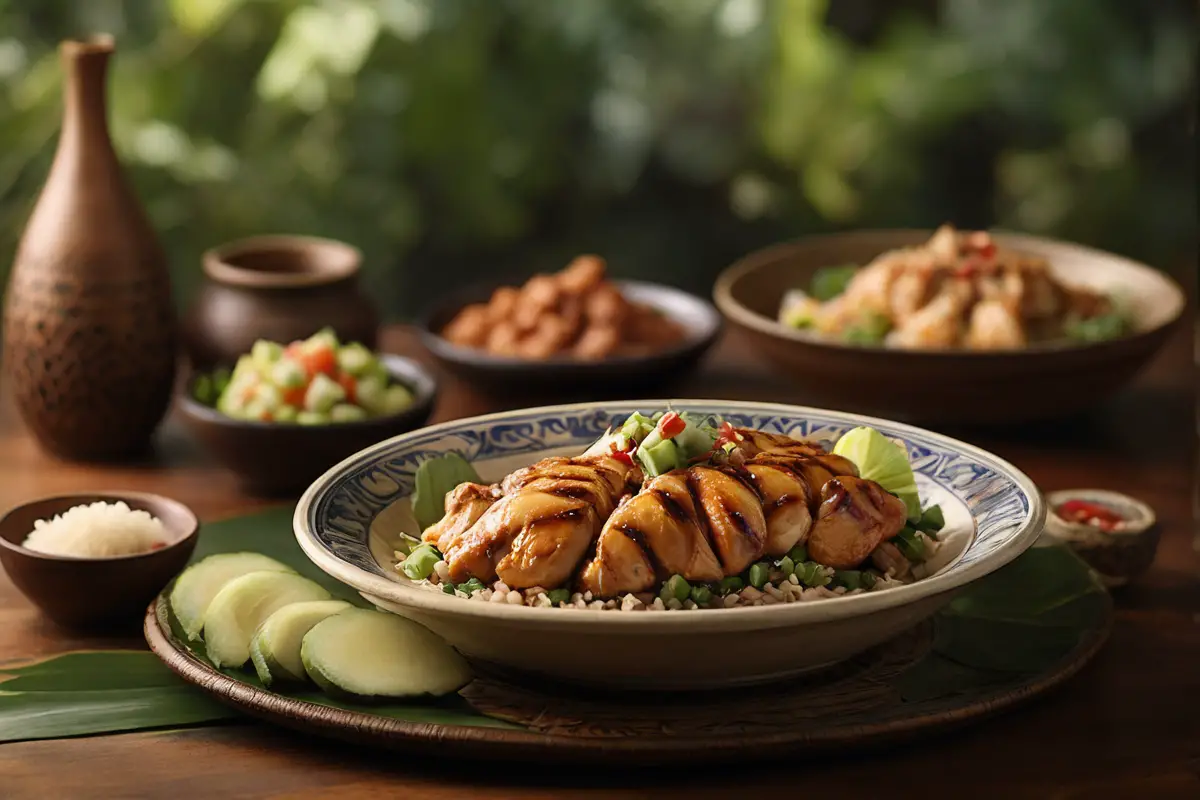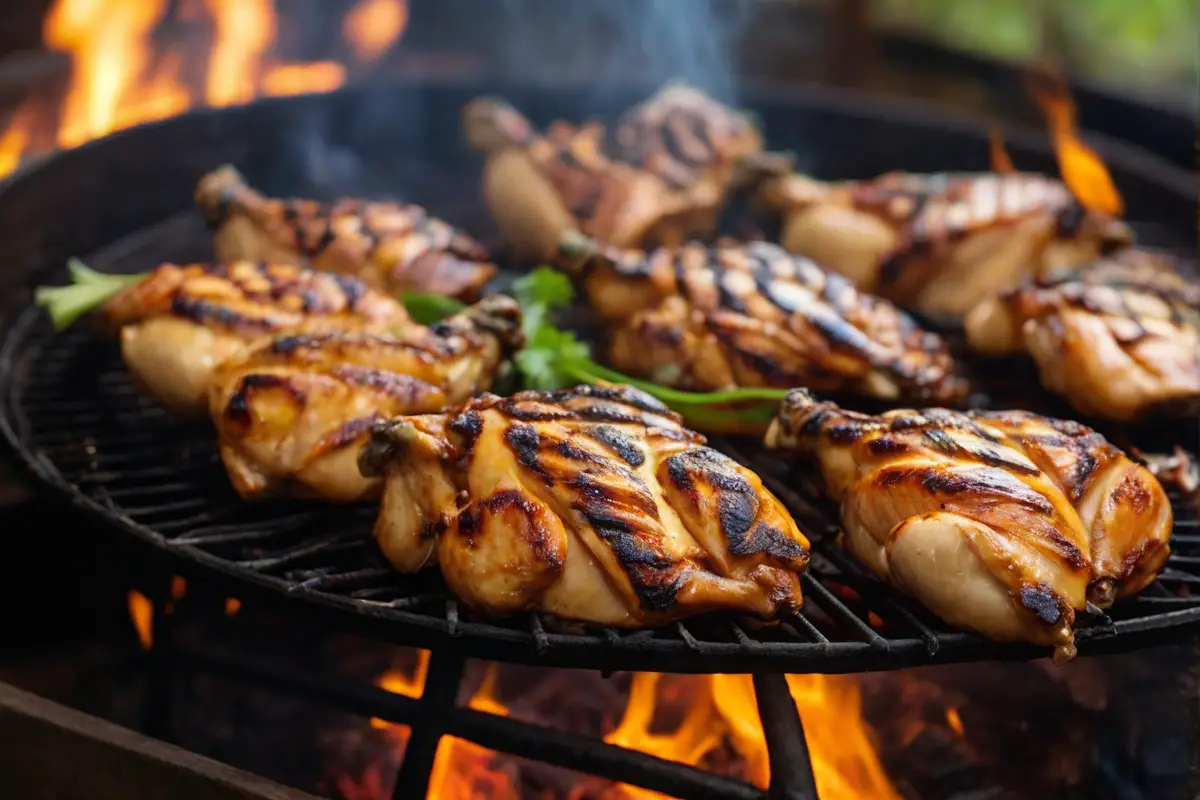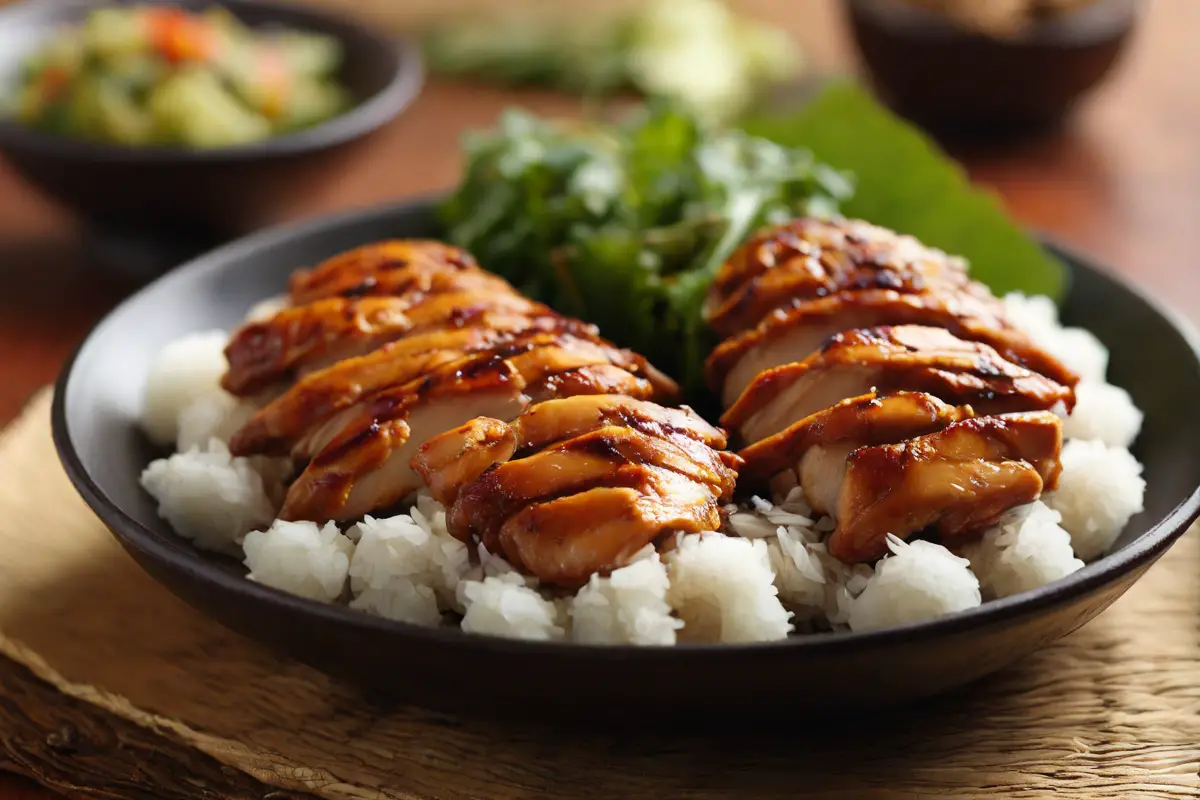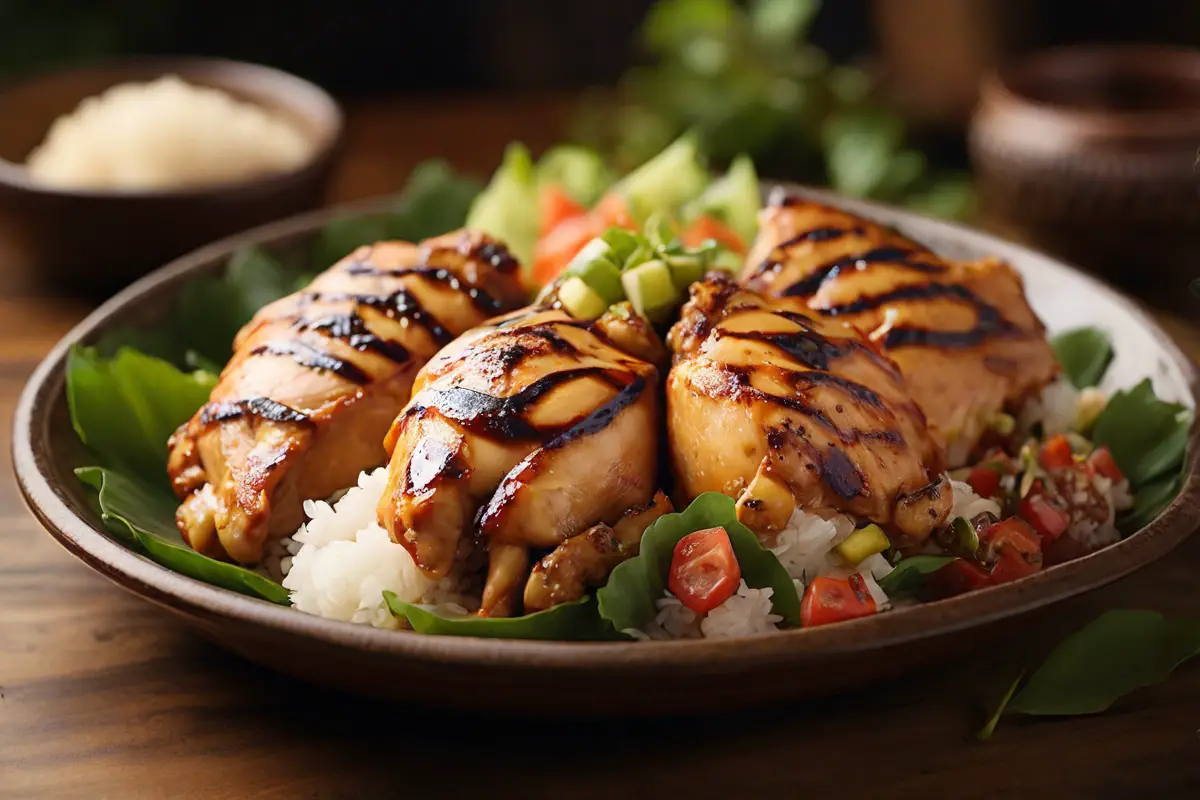Introduction to Pulehu Chicken
Aloha! Welcome to the flavorful world of Pulehu Chicken, a Hawaiian culinary gem that’s as delightful to cook as it is to eat. This article is your ultimate guide to mastering Pulehu Chicken, a dish that embodies the spirit of Hawaiian BBQ with its smoky, savory, and slightly sweet flavors. Whether you’re a grilling novice or a seasoned pro, this guide will walk you through every step of creating this tropical delight, from choosing the right ingredients to serving it up with style. So, let’s fire up the grill and embark on a culinary journey to the Hawaiian Islands!
The Hawaiian Culinary Tradition
Pulehu, meaning “to broil over a fire” in Hawaiian, is a traditional cooking method that’s been part of Hawaii’s culinary heritage for generations. Pulehu Chicken is a classic example of this technique, where the simplicity of grilling meets the complexity of Hawaiian flavors.
What Makes Pulehu Chicken Unique?
What sets Pulehu Chicken apart is its unique marinade and the method of grilling over an open flame. This cooking style imparts a distinct charred flavor while keeping the chicken juicy and tender. It’s a perfect dish for outdoor gatherings, bringing a taste of Hawaiian BBQ to your backyard.
In the next part, we’ll explore the essential ingredients needed to create the authentic flavors of Pulehu Chicken.
For more insights on traditional Hawaiian cooking techniques, check out Exploring Traditional Hawaiian Cooking. Understanding the roots of this cuisine is key to authentic preparation.
Selecting the Right Ingredients
Types of Chicken Cuts
Choosing the right cut of chicken is crucial for Pulehu Chicken. Traditionally, bone-in, skin-on chicken thighs are used for their rich flavor and ability to stay moist during grilling. However, you can also use other cuts like drumsticks or wings. The key is to select pieces that can withstand the high heat of the grill without drying out.
Key Marinade Ingredients
The marinade is what gives Pulehu Chicken its unique flavor. Key ingredients include soy sauce for umami, brown sugar for sweetness, garlic for aroma, and ginger for a spicy kick. Some recipes also call for a touch of sesame oil or Hawaiian salt to enhance the flavors. The combination of these ingredients creates a harmonious balance that is quintessentially Hawaiian.
In the next part, we’ll dive into the preparation of the perfect Pulehu marinade, ensuring your chicken is infused with all the right flavors.

Crafting the Perfect Pulehu Marinade
Marinade Ingredients and Ratios
The secret to a flavorful Pulehu Chicken lies in its marinade. Start with a base of soy sauce for depth and umami. Add brown sugar to balance the saltiness with a hint of sweetness. Freshly grated ginger and minced garlic contribute a pungent, aromatic quality that’s essential in Hawaiian cooking. For an authentic touch, a splash of sesame oil adds a nutty flavor, while a pinch of Hawaiian salt (or sea salt) enhances the overall taste.
Marination Time and Techniques
Marination time is key to infusing the chicken with flavor. Ideally, let the chicken marinate for at least an hour, or for deeper flavor, overnight in the refrigerator. Ensure each piece is evenly coated and turn them occasionally for uniform absorption. The longer the marination, the more pronounced the flavors will be in the final dish.
In the next part, we’ll explore the art of grilling Pulehu Chicken to achieve that perfect char and succulent texture.
Mastering the Art of Grilling Pulehu Chicken
Grill Setup and Temperature Control
Grilling is an art, especially when it comes to Pulehu Chicken. Start by setting up your grill for medium-high heat. If you’re using a charcoal grill, let the coals burn until they’re covered with ash and emit a steady heat. For gas grills, preheat to the desired temperature. The right temperature is crucial – too hot, and the chicken will burn on the outside before cooking through; too low, and you’ll miss that signature char.
Achieving the Perfect Char
Place your marinated chicken on the grill, skin side down first. Grill each side until it’s nicely charred and the juices run clear, usually about 5 to 7 minutes per side, depending on the thickness. Avoid flipping the chicken too often, as this can prevent the formation of that delicious charred crust. Use a meat thermometer to ensure the chicken reaches a safe internal temperature of 165°F (75°C).
In the next part, we’ll discuss serving suggestions and pairings to complement your Pulehu Chicken, enhancing the overall dining experience.

Serving and Pairing
Accompaniments and Side Dishes
Once your Pulehu Chicken is perfectly grilled, it’s time to think about accompaniments. Traditional Hawaiian sides like poi (taro paste) or a fresh pineapple salsa can complement the smoky flavors of the chicken. For a more familiar approach, serve it with steamed rice, a tangy coleslaw, or a refreshing green salad. These sides not only add variety to your meal but also balance the rich flavors of the chicken.
Beverage Pairings
When it comes to beverages, you want something that can stand up to the bold flavors of Pulehu Chicken. A light, crisp beer or a chilled glass of Riesling pairs beautifully with the smoky and slightly sweet notes of the chicken. For a non-alcoholic option, consider iced tea with a hint of lemon or a tropical fruit punch.
In the next part, we’ll delve into the nutritional benefits of Pulehu Chicken and how to enjoy it as part of a balanced diet.
Nutritional Information
Health Benefits
Pulehu Chicken isn’t just delicious; it also offers several nutritional benefits. Chicken is a great source of lean protein, essential for muscle growth and repair. The marinade ingredients like garlic and ginger add not only flavor but also contain anti-inflammatory and antioxidant properties. If you’re using skinless chicken, it’s also a lower-fat option compared to other meat dishes.
Dietary Considerations
For those watching their diet, Pulehu Chicken can be a healthy choice if prepared thoughtfully. Opt for skinless chicken cuts to reduce fat content and consider using a low-sodium soy sauce in the marinade to control salt intake. Grilling, as a cooking method, also requires less added fat compared to frying, making it a healthier option.
In the next part, we’ll answer some frequently asked questions about Pulehu Chicken, providing additional tips and insights for this Hawaiian BBQ favorite

Common Queries and Tips
Q1: Can Pulehu Chicken be made in an oven?
Yes, while grilling is traditional, you can also make Pulehu Chicken in an oven. Broil the marinated chicken pieces, turning once, until they’re cooked through and have a slight char on the surface.
Q2: How long should I marinate the chicken for optimal flavor?
For the best flavor, marinate the chicken for at least one hour. However, for a deeper infusion of flavors, marinating overnight in the refrigerator is ideal.
Q3: What are some vegetarian alternatives for Pulehu-style cooking?
For a vegetarian option, try grilling marinated tofu, tempeh, or vegetables like bell peppers and zucchini using the Pulehu method.
Q4: How can I ensure my chicken doesn’t dry out on the grill?
To prevent drying, don’t overcook the chicken. Keep the grill at a medium-high temperature and turn the chicken pieces frequently. Using cuts with a bit of fat, like thighs, can also help.
Q5: Are there any low-sugar alternatives for the marinade?
For a low-sugar version, reduce or omit the brown sugar in the marinade. You can substitute it with a sugar-free sweetener or enhance the other flavors to compensate.
In the next part, we’ll share some advanced grilling tips and variations for making Pulehu Chicken, offering ways to add a creative twist to this classic dish.
Advanced Grilling Tips
Flavor Enhancements
To elevate your Pulehu Chicken, consider adding unique flavor enhancements to your marinade. Ingredients like pineapple juice can add a tropical sweetness, while a splash of chili sauce can introduce a spicy kick. Experimenting with different herbs and spices, such as cilantro or paprika, can also add a new dimension to the traditional flavor profile.
Grilling Techniques for Different Cuts
Different cuts of chicken require varying grilling techniques for optimal results. For example, chicken breasts, being leaner, should be grilled quickly over higher heat to retain moisture. Thighs and drumsticks, which have more fat, can be cooked slower over medium heat to render the fat and ensure even cooking. Always use a meat thermometer to check for doneness, aiming for an internal temperature of 165°F (75°C).
In the conclusion, we’ll wrap up our comprehensive guide on making Pulehu Chicken. Get ready to impress your family and friends with your new grilling skills!
Conclusion
As we wrap up our culinary journey with Pulehu Chicken, it’s clear that this Hawaiian BBQ favorite is more than just a dish; it’s a celebration of flavors, techniques, and the joy of grilling. From the careful preparation of the marinade to mastering the grill, each step in creating Pulehu Chicken is an opportunity to explore and enjoy the art of cooking.
Remember, the essence of Pulehu cooking lies in its simplicity and the use of fresh, quality ingredients. Whether you’re cooking for a family dinner or a backyard BBQ party, Pulehu Chicken is sure to be a crowd-pleaser. So, fire up your grill, gather your friends and family, and share the aloha spirit through the delightful flavors of this Hawaiian grilled chicken. Happy grilling!
After enjoying the savory delights of Pulehu Chicken, why not treat yourself to a sweet dessert? Our Lemon Blueberry Cheesecake offers a symphony of flavors that perfectly complements the smoky taste of the chicken. Its tangy lemon and sweet blueberry layers make for a refreshing end to your meal
Looking for the perfect side dish to accompany your Pulehu Chicken? Our Vesuvio Potatoes are a culinary journey in themselves. These perfectly roasted potatoes, seasoned with herbs and spices, are an excellent match for the bold flavors of Hawaiian BBQ
If you’re in the mood for a luxurious dessert after your Hawaiian BBQ, our Tuxedo Cake is the perfect choice. Learn what makes this cake so special and how its rich, chocolatey layers can be a decadent follow-up to a meal of Pulehu Chicken.

